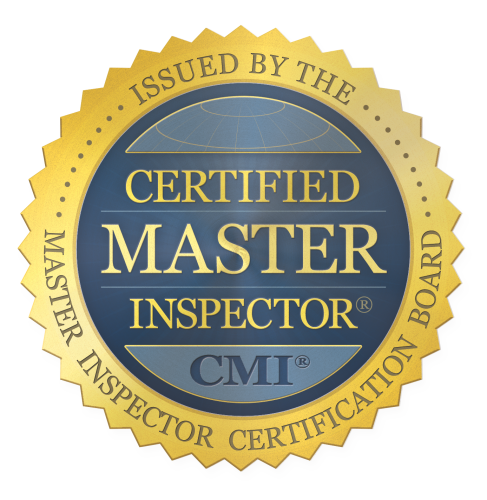Thermal Infrared Imaging Inspections
How Thermal Infrared Imaging Works
What is it?
Thermography measures surface temperatures or "sees" density by using infrared video or camera settings. It is essentially "FLIR" technology (Forward Looking Infrared Radar)similar to what is used in military applications on helicoptors. An inspection in the home is quick and definitive. A thermal image inspection can find various, previously undetected problems in many areas of any home, old or new. An inspection can be performed inside or out, in any season. A photo is taken of any problem and can even show temperatures or moisture densities. These photos print into a report which is easy to read and perfectly understandable. Jay utilizes the excellent FLIR camera and reporting system. It is a powerful and portable device, and can be taken anywhere inside or outside the home. The printed report includes all thermal photos taken, with everything explained for understanding.
Unlike the reflected light our eyes see, the infrared camera sees very long light waves not detected by the human eye. As such, the camera detects heat energy which is radiated from objects as well as reflected from other heat sources. The thermal imaging equipment can virtually "see in the dark".
When conditions change in a viewed object, a temperature differential or anomaly becomes apparent. Identification of exactly what the anomaly is must be further investigated with other testing equipment to verify the source.
Things that cause an anomaly are numerous. They often occur from:
- Air infiltration - due to inadequate building envelopes, like caulking and insulation, or air leakage from mechanical equipment like the air exchanger or duct work, and windows and doors.
- Moisture intrusion - water retains its heat longer and appears warm. A below-ground leak, or siding or roof, say from an ice dam, may be cooler than the surrounding material and show up as a cool spot as well.
- Evaporative cooling - liquids cool below the ambient, surrounding air temperature as they evaporate and appear cool.
- Condensation - water vapor warms the cool object that condenses water vapor to a liquid.
- Specific density changes - the ability of a substance to retain its heat will change when deterioration from rot or insect infestation occurs.
- Changes in fluid flow - increased or decreased fluid flow are apparent during the heat exchange in hydronic heating equipment and even blood flow.
- Equipment performance - the first sign of impending equipment failure is increased heat, like a circuit breaker in an electric panel box.
A thermal scan is not actually a photograph, rather a display of 307,200 individual temperature readings (in some cameras).
Advantages of thermal imaging is that non-contact temperature readings can be obtained without touching the object. This is particularly advantageous when we are not able to access the object or that a system must be shut down for evaluation. Jay performs a thermal imaging sweep of the house during every home inspection for FREE. Every thermal image taken with the camera is included with the report, with a complete explanation.
A Thermal Image Home Inspection
How is it done? An energy audit.
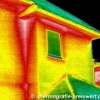
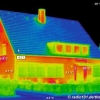 A thermal energy audit can be done from outside or inside, or both! From the exterior, it can show areas where expensive heated or air conditioned air is escaping. From the inside it similarly shows where warm or cold air is entering. Both steps pinpoint areas where improvements can be made. It is not uncommon to see whole walls or ceilings with inadequate or even no insulation!
A thermal energy audit can be done from outside or inside, or both! From the exterior, it can show areas where expensive heated or air conditioned air is escaping. From the inside it similarly shows where warm or cold air is entering. Both steps pinpoint areas where improvements can be made. It is not uncommon to see whole walls or ceilings with inadequate or even no insulation!
Finding these spots
saves you money! 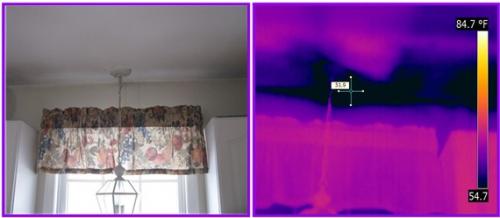 The images to the right are of a window in a kitchen that was always hot or cold, depending on the season. The dark areas in the infrared image are in the wall and ceiling above the window and show that there is little and no insulation! Note the temperature difference between warm and cold!
The images to the right are of a window in a kitchen that was always hot or cold, depending on the season. The dark areas in the infrared image are in the wall and ceiling above the window and show that there is little and no insulation! Note the temperature difference between warm and cold!
Other major sources of energy losses include batt insulation that has shifted inside the wall, access plates for electrical outlets or phone jacks, and cannister lights, smoke alarms or ceiling fans not properly insulated after installation. Also, not widely thought about, are leaks from heating and air conditioning ducts. You can be heatiing or cooling the insides of your walls or attic without even knowing it. Improperly insulated or settling windows and doors are other major energy wasters. If your home seems to be never warm or cool enough, and the system is running all the time, it is probably due to numerous small leaks around windows and doors. They can add up.
How is it done? A moisture audit.
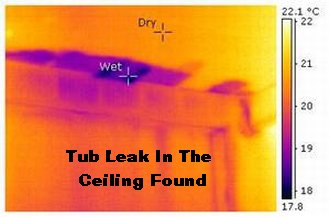 Water is THE killer of houses. Moisture damage is the most common form of damage to a house. It is very possible that insulation inside your home has had water damage of some type. This damage does not require a visible leak or may only happen when it rains from a particular direction. Wet insulation takes a long time to dry and becomes a prime source of molds and fungus. Insulation, when wet, has an insulating property of almost zero and can actually be pulling heat out of the house like a sponge. This is easily detected with a thermal imager. Excess condensation, like in an attic, is similarly visible with a thermal imager. Inside the house, water can be coming from sources as various as the roof, plumbing leaks inside walls, foundation cracks, windows, doors, flashing, stucco - you name it. A thermal imager "sees" it all.
Water is THE killer of houses. Moisture damage is the most common form of damage to a house. It is very possible that insulation inside your home has had water damage of some type. This damage does not require a visible leak or may only happen when it rains from a particular direction. Wet insulation takes a long time to dry and becomes a prime source of molds and fungus. Insulation, when wet, has an insulating property of almost zero and can actually be pulling heat out of the house like a sponge. This is easily detected with a thermal imager. Excess condensation, like in an attic, is similarly visible with a thermal imager. Inside the house, water can be coming from sources as various as the roof, plumbing leaks inside walls, foundation cracks, windows, doors, flashing, stucco - you name it. A thermal imager "sees" it all.
How is it done? Other audits.
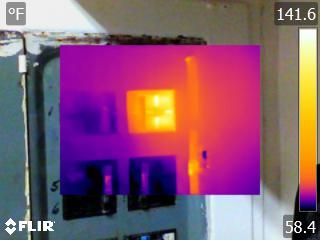 Electrical problems or overloads from too many appliances or faulty wiring can be detected through thermal imaging. Whenever there is a circuit which is running hot, and actually heating the wiring, the electricity is running and costing you money. Such wasted electricity is almost never known about, but pinpointed exactly.
Electrical problems or overloads from too many appliances or faulty wiring can be detected through thermal imaging. Whenever there is a circuit which is running hot, and actually heating the wiring, the electricity is running and costing you money. Such wasted electricity is almost never known about, but pinpointed exactly.
Water damage over time causes changes conducive to mold. Mold is never the problem, only the symptom of water problems, be they leaks or inherent moisture. Scanning with infrared cameras can "see" moisture which creates an environment encouraging the amplification of molds - locations that could never be seen with the human eye. We may smell its presence, but not know where it is forming. Infrared cameras can often determine where inherently moist areas are located, which can encourage potentially serious mold and health problems. 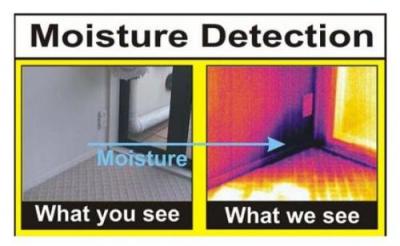 The previously-undetected location below would be one such place!
The previously-undetected location below would be one such place!
Interestingly, it is also sometimes possible to detect insects and insect damage with thermal imaging. Damage and/or heat caused by termites and wood burrowing ants create changes in the density of the wood. This affects how an infrared camera sees the wood as compared with normal undamaged wood nearby. Honey bee hives actually produce their own heat and therefore their heat signatures 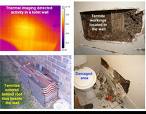 are sometimes visible inside walls. Rodents and other small animals which may be nestling inside your walls can also be detected with a thermal infrared camera. It can detect either body heat or the damage they may have caused. The image to the left was not a logical location for heat, being an inside wall and demonstrated by the yellow area in the upper-left image. What could create such heat? A view inside the wall tells the rest of the story... the upper-right image shows an advanced termite colony. Notice the source of the problem - outside the house. Termites will use any means of getting into a house, and need a very small crack to do so, as small as 1/64 of an inch! They are searching for food, and this homeower was providing a buffet! Any wood product outside the house, such as a wood pile or mulch, will do the same thing! Homeowners should pay strict attention to what they place around, near or next to their houses.
are sometimes visible inside walls. Rodents and other small animals which may be nestling inside your walls can also be detected with a thermal infrared camera. It can detect either body heat or the damage they may have caused. The image to the left was not a logical location for heat, being an inside wall and demonstrated by the yellow area in the upper-left image. What could create such heat? A view inside the wall tells the rest of the story... the upper-right image shows an advanced termite colony. Notice the source of the problem - outside the house. Termites will use any means of getting into a house, and need a very small crack to do so, as small as 1/64 of an inch! They are searching for food, and this homeower was providing a buffet! Any wood product outside the house, such as a wood pile or mulch, will do the same thing! Homeowners should pay strict attention to what they place around, near or next to their houses.
The Department of Energy now recommends a thermal imaging inspection and/or energy audit of every house, for all of the various reasons described above. Click here to see what they have to say.
Every homeowner should take advantage of this cutting-edge home inspection ability. It has been estimated that only 3% of home inspectors nationwide use thermal imaging technology. It might be less than that in Virginia and metro Washington D.C. Even fewer are infrared certified.
Jay is a Level I thermographer
certified by the Infraspection Institute.
INSIST on Jay Markanich!
Office (703) 330-6388 Cell (703) 585-7560
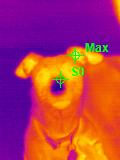
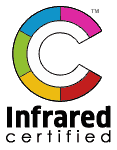
Here with warm ears and eyes, cold nose.
23 July 1993 - 24 December 2010

